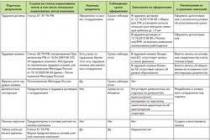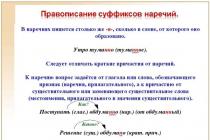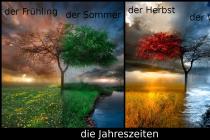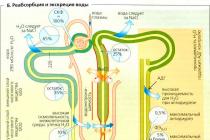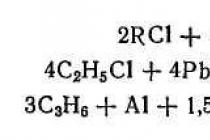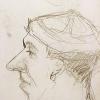Topic 1.1. Introduction to Psychology.
Basic Concepts: reflection, psyche, mental reflection, consciousness, unconscious.
Questions to study:
1. Characteristics of human consciousness.
Scientists of the materialist school explain the emergence of the psyche by the long-term development of matter. All matter, starting from lifeless, inorganic, and ending with the highest and most complex matter - the human brain, has the universal quality of the material world - the quality reflections, those. ability to respond to influences. The forms of reflection depend on the forms of existence of matter: reflection is manifested in the ability to respond to external influences in accordance with their nature and the form of existence of matter.
1. Characteristics of human consciousness.
The main difference between the human psyche and the psyche of animals is the conscious purposefulness and arbitrariness of mental processes caused by vigorous activity, social interaction and the formative influence of cultural factors.
At the level of specifically human existence, the psyche acquires a qualitatively new structure, determined by socio-historical patterns. Its essential characteristic becomes consciousness– the leading level of regulation of activity, and the form of the highest manifestations of mental activity is personality.
Consciousness is interpreted in Russian psychology as the highest level of a person’s mental reflection of reality in the form of generalized images and concepts, mediated by the socio-historical activities of people. The forms of existence of consciousness are thinking and speech. The understanding of consciousness as social in nature (“co-knowledge” as shared “knowledge”) has become firmly established. Along with social conditioning, consciousness is characterized by activity (direction towards a specific object), varying degrees of clarity, motivational-value character and the ability to reflect - introspection and reflection of one’s own contents. Mastery of language, a system of signs, symbols and meanings is of great importance for the formation of human consciousness.
Biological (upright walking, anatomical development, herd lifestyle) and historical (making and preserving tools, relationships during collective activities) prerequisites for the emergence and development of human consciousness:
The human psyche was prepared by the entire course of the evolution of matter, but speaking of biological prerequisites for the emergence of consciousness We must not forget that man is a product of social relations. Biological prerequisite social relations there was a herd, which allowed all individuals to best protect themselves from enemies, providing mutual assistance to each other. The factor influencing the transformation of a monkey into a person, a herd into a society, was labor activity, i.e. such activity that is performed by people during the joint production and use of tools.
Instinctive communication human ancestors within the herd were gradually replaced communication based on “production” activities. Changing relationships between members of the community - joint activities, mutual exchange of products of activity - contributed to the transformation of the herd into a society. Thus, cause of humanization animal-like human ancestors was the emergence of labor and the formation of human society.
Since the activity of one person is included in the activity of the whole society, it is aimed at satisfying not only personal, but also social needs. Therefore, there is a need for a person to have a critical attitude towards his activities. Human activity becomes conscious. At a high level of tool production, the integral activity of tool making is divided into a number of units, each of which can be performed by different members of society. Separating operations pushes the ultimate goal – getting food – even further. Only a person with abstract thinking can realize this pattern. This means that a high-level production of tools, developing under the social organization of labor, is the most important condition in the formation of conscious activity.
Under the influence of labor, new functions of the hand were consolidated: it develops not only as a grasping tool, but also as an organ of cognition of objective reality, a specialized organ of active touch. The specialization of the hand as an organ of labor contributed to the development of upright walking.
The functioning of the hand had a particularly great influence on the development of the brain. The hand, as a developing specialized organ, should also have formed a representation in the brain. This caused not only an increase in the mass of the brain, but also a complication of its structure.
Thus, labor served as the reason for the development of human society, the formation of human needs, the development of human consciousness, which not only reflects, but also transforms the world. All these phenomena in human evolution led to a radical change in the form of communication between people. The need to pass on the experience of previous generations, teach labor actions to fellow tribesmen, and distribute individual actions between them created the need for communication. The language of instincts could not satisfy this need. Thus, the need arose for the development of a higher form of communication - human language.
For the stage of consciousness characteristic:
Reflection as a way for a person to understand himself, his activities and behavior;
Reflection as self-control and self-education;
Reflection as a way of knowing others;
Reflection as a way of understanding social life and social relations.
The structure of consciousness a person is made up of the following characteristics:
His first characteristic given already in its very name: co-knowledge, i.e. the body of knowledge about the world around us. The structure of consciousness thus includes the most important cognitive processes with the help of which a person constantly enriches his knowledge.
Second characteristic of consciousness– clearly enshrined in it distinction between subject and object, those. of what belongs to a person’s “I” and his “not-I”. Man, who for the first time in the history of the organic world stood out from it and opposed himself to it, retains this opposition and difference in his consciousness. The separation of “I” from “not-I” - the path that every person goes through in childhood, is carried out in the process of forming a person’s self-awareness.
The third characteristic of consciousness is ensuring goal-setting human activity. When starting any activity, a person sets himself certain goals. At the same time, her motives are formed and weighed, strong-willed decisions are made, the progress of actions is taken into account and the necessary adjustments are made to it, etc.
Finally, The fourth characteristic of consciousness is the presence of emotional assessments in interpersonal relationships. And here, as in many other cases, pathology helps to better understand the essence of normal consciousness. In some mental illnesses, a violation of consciousness is characterized by a disorder specifically in the sphere of feelings and relationships: the patient hates his mother, whom he previously loved dearly, speaks with anger about loved ones, etc.
The lowest level of the psyche forms the unconscious. The unconscious is a set of mental processes, acts and states caused by influences, the influence of which a person is not aware of. Being mental (since the concept of the psyche is broader than the concept of “consciousness”, “conscious”), the unconscious is a form of reflection of reality in which the completeness of orientation in time and place of action is lost, and speech regulation of behavior is disrupted. In the unconscious, unlike consciousness, purposeful control over the actions performed is impossible, and evaluation of their results is also impossible. The area of the unconscious includes mental phenomena that occur during sleep (dreams); responses that are caused by imperceptible, but actually acting stimuli (“subsensory” or “subceptive” reactions); movements that were conscious in the past, but through repetition have become automated and therefore become unconscious; some impulses to activity in which there is no consciousness of purpose, etc. Unconscious phenomena also include some pathological phenomena that arise in the psyche of a sick person: delusions, hallucinations, etc.
Concept "mentality" is used to highlight special phenomena in the sphere of consciousness, which in a particular social environment characterize its differences from other communities. If we “subtract” from the public consciousness what constitutes the universal principle, in the “remainder” we will find the mentality of this society. So, mentality is a set of views, opinions, stereotypes, forms and methods of behavior accepted and generally approved by society, which distinguishes it from other human communities. In the consciousness of its individual member, the mentality of society is represented to a degree that depends on his active or passive position in public life. Being, along with science, art, mythology, and religion, one of the forms of social consciousness, mentality is not fixed in materialized products, but, so to speak, is dissolved in the atmosphere of society and has a supraconscious character.
Questions for control:
- Tell us about the prerequisites and conditions for the emergence and development of human consciousness. Give a psychological description of human consciousness.
- Reveal the essence of the concepts “unconscious” and “mentality”.
Literature:
1. Introduction to psychology / Under general. ed. prof. A.V. Petrovsky. – Moscow: Publishing Center “Academy”, 1996.
2. Krysko V.G. Psychology and pedagogy in diagrams and tables. – Mn: Harvest, 1999.
3. Filatov F.R. General psychology. Series "Highest Score". Rostov-on-Don: Phoenix, 2003.
Consciousness is the highest, human-specific form of generalized reflection of the objective stable properties and patterns of the surrounding world, the formation of a person’s internal model of the external world, as a result of which knowledge and transformation of the surrounding reality is achieved. The function of consciousness is to formulate the goals of activity, to preliminary mentally construct actions and anticipate their results, which ensures reasonable regulation of human behavior and activity. A person’s consciousness includes a certain attitude towards the environment and other people. The following properties of consciousness are distinguished: building relationships, cognition and experience. This directly follows the inclusion of thinking and emotions in the processes of consciousness. Indeed, the main function of thinking is to identify objective relationships between phenomena of the external world, and the main function of emotion is the formation of a person’s subjective attitude towards objects, phenomena, and people. These forms and types of relationships are synthesized in the structures of consciousness, and they determine both the organization of behavior and the deep processes of self-esteem and self-awareness. Really existing in a single stream of consciousness, an image and a thought can, colored by emotions, become an experience. Consciousness develops in humans only through social contacts. In phylogenesis, human consciousness developed and becomes possible only under conditions of active influence on nature, in conditions of labor activity. Consciousness is possible only in the conditions of the existence of language, speech, which arises simultaneously with consciousness in the process of labor. And the primary act of consciousness is the act of identification with the symbols of culture, which organizes human consciousness, making a person human. The isolation of meaning, symbol and identification with it is followed by implementation, the child’s active activity in reproducing patterns of human behavior, speech, thinking, consciousness, the child’s active activity in reflecting the world around him and regulating his behavior. There are two layers of consciousness (V.P. Zinchenko). I. Existential consciousness (consciousness for being), which includes: 1) biodynamic properties of movements, experience of actions; 2) sensory images. II. Reflective consciousness (consciousness for consciousness), including: 1) meaning; 2) meaning. Meaning is the content of social consciousness, assimilated by a person. These can be operational meanings, objective, verbal meanings, everyday and scientific meanings - concepts. Meaning is a subjective understanding and attitude towards a situation and information. Misunderstandings are associated with difficulties in comprehending meanings. The processes of mutual transformation of meanings and senses (understanding of meanings and meaning of meanings) act as a means of dialogue and mutual understanding. At the existential layer of consciousness, very complex problems are solved, since for effective behavior in a given situation, it is necessary to update the image and the necessary motor program needed at the moment, i.e. the way of action must fit into the image of the world. The world of ideas, concepts, everyday and scientific knowledge correlates with the meaning (of reflective consciousness). The world of industrial, objective-practical activity correlates with the biodynamic fabric of movement and action (the existential layer of consciousness). The world of ideas, imaginations, cultural symbols and signs correlates with the sensory fabric (of existential consciousness). Consciousness is born and is present in all these worlds. The epicenter of consciousness is the consciousness of one's own “I”. Consciousness: 1) is born in being, 2) reflects being, 3) creates being. Functions of consciousness: 1. reflective, 2. generative (creative-creative), 3. regulatory-evaluative, 4. reflective function - the main function that characterizes the essence of consciousness. The object of reflection can be: 1. reflection of the world, 2. thinking about it, 3. ways a person regulates his behavior, 4. the processes of reflection themselves, 5. his personal consciousness. The existential layer contains the origins and beginnings of the reflective layer, since meanings and meanings are born in the existential layer. The meaning expressed in a word contains: 1) an image, 2) an operational and objective meaning, 3) a meaningful and objective action. Words and language do not exist only as language; they objectify the forms of thinking that we master through the use of language.
Consciousness- the highest, human-specific form of generalized reflection of the objective stable properties and patterns of the surrounding world, as well as the creation of an internal model of the external world, as a result of which knowledge and transformation of the surrounding reality are possible.
Function of consciousness- formation of activity goals, preliminary mental construction of actions and anticipation of their results, which ensures reasonable regulation of human behavior and activity. A person’s consciousness includes a certain attitude towards the environment and other people. “My relationship to my environment is my consciousness,” noted K. Marx.
The following properties of consciousness are distinguished: relationship building, cognition And experience. Therefore, thinking and emotions are also included here. Indeed, the main function of thinking is to identify objective relationships between phenomena of the external world, and emotions are to create a person’s subjective attitude towards objects, phenomena, and people. In the structures of consciousness, these forms and types of relationships are synthesized and then determine both the organization of behavior and the deep processes of self-esteem and self-awareness.
Really existing in a single stream of consciousness, an image and a thought can, colored by emotions, become an experience. “Awareness of an experience is always the establishment of its objective relation to the reasons that cause it, to the objects to which it is directed, to the actions by which it can be realized” (S. L. Rubinstein).
Rice. 4.1.
Consciousness develops in a person only in social contacts. In phylogenesis, it developed only under conditions of active influence on nature - during labor activity. Consciousness is possible only when language exists, speech that arises simultaneously with it in the process of labor.
During ontogenesis, the child’s consciousness goes through a complex, indirect path. The infant’s psyche, generally speaking, cannot be considered as isolated and independent. From the very beginning there is a stable connection with the mother’s psyche. In the prenatal and postnatal periods, this connection can be called mental (sensual). However, the child is at first only a passive element, a perceiving substance, and the mother, who has a psyche formed by consciousness, transmits not just psychophysical, but also information formed thanks to consciousness.
Another point is the mother’s activity itself. The child’s primary organic needs for warmth, psychological comfort, etc. are organized and satisfied externally by her loving attitude towards her child. The mother, with a loving gaze, “catches” and evaluates everything valuable, from her point of view, in the initially chaotic reactivity of the child’s body and gradually, lovingly, cuts off everything that deviates from the social norm. It is also important here that the norms of development, like motherhood, are already present in human society. Thus, with love for the child, the mother, as it were, pulls him out of organic reactivity, unconsciousness and draws him into human culture, into the sphere of people’s consciousness. 3. Freud noted that “the mother teaches to love the child”; she “puts” her love (attitude) into his psyche, since the mother’s image is for children’s feelings and perceptions the real center of all acts, benefits and troubles.
The next stage of development can be called The primary act of consciousness is the identification of the child with the mother when he tries to put himself in her place, imitate and become like her. This represents, apparently, a primary human relationship, a window into culture cut through maternal love for the child, an initial act of consciousness.
Primary attitude of consciousness(and not an objective one) is identification with a cultural symbol, since the mother acts as a cultural model of social behavior, and the child just carries it out. This is the starting point of a person’s life path, the development of consciousness. And it is identification with the symbols of culture that organizes human consciousness and makes a person human. The isolation of meaning, symbol and identification with it is followed by the child’s implementation, active activity in reproducing patterns of human behavior, speech, thinking, consciousness, reflecting the world around him and regulating his behavior.
But the realization of the meaning of a cultural symbol, sample entails the activation of the layer of consciousness rationalized by it, which can develop relatively independently through reflection and analysis (mental activity). In a sense, awareness is the opposite of reflection. If it comprehends the integrity of the situation and gives a picture of the whole, then reflection, on the contrary, divides the whole - for example, it looks for the cause of difficulties, analyzing the situation based on the goal of the activity. Thus, awareness is a condition for reflection, but the latter, in turn, is necessary for a higher, deeper and more accurate understanding of the situation as a whole.
Our consciousness in its development is associated with many identifications, but not all are realized. These unrealized potentialities constitute what we usually denote by the word soul, which is a mostly unconscious part of our consciousness. Although, to be precise, it must be said that the symbol as the infinite content of consciousness cannot be fully realized and therefore consciousness periodically returns to itself.
From here follows the third fundamental act of consciousness - awareness of an unfulfilled desire. Thus the circle of development closes, and everything returns to its beginning.

Rice. 4.2.
There are two layers of consciousness (V.P. Zinchenko):
- Being consciousness(consciousness concerning being) is:
- biodynamic properties of movements, experience of actions;
- sensual images.
- Reflective Consciousness(consciousness relating to consciousness), including:
- meaning;
- meaning.
Meaning- the content of social consciousness, assimilated by a person. These can be operational, subject, verbal, everyday and scientific meanings.
Meaning- subjective understanding of the situation, information and attitude towards it. Misunderstandings are associated with difficulties in comprehending meanings. The processes of mutual transformation of meanings and senses (understanding of meanings and meaning of meanings) act as a means of dialogue and mutual understanding.
At the existential layer of consciousness, very complex problems are solved, since for effective behavior in a given situation it is necessary to update the image needed at the moment and the required motor program. The method of action must fit into the image of the world.
The world of ideas, concepts, everyday and scientific knowledge correlates with the meaning (of reflective consciousness). The world of human values, experiences, emotions - with meaning (reflective consciousness). The world of industrial, objective-practical activity - with a biodynamic fabric of movement and action (the existential layer of consciousness). The world of ideas, imagination, cultural symbols and signs - with a sensory fabric (existential consciousness). Consciousness relates to all these worlds and is present in all of them.
The center of consciousness is the consciousness of one’s own Self. Consciousness:
- is born into being;
- reflects being;
- creates being. Functions of consciousness:
- reflective;
- generative (creative);
- regulatory and evaluation;
- reflexive (basic, it characterizes the essence of consciousness). The object of reflection can be:
- reflection of the world;
- thinking about it;
- ways a person regulates his behavior;
- the processes of reflection themselves;
- your personal consciousness.
The existential layer contains the origins and beginnings of the reflective, since meanings and meanings are born in it. The meaning expressed in a word contains:
- image;
- operational and substantive meaning;
- meaningful and objective action.
Words do not exist only as language; they objectify forms of thinking, which are expressed through language itself.

The zone of clear consciousness reflects a small part of signals simultaneously coming from the external and internal environment of the body. Those of them that fall into this zone are used by a person to consciously control his behavior. The rest are also taken into account by the body to regulate certain processes, but at a subconscious level.
Research by psychologists has shown that those objects that create obstacles to the continuation of the previous regulatory regime immediately fall into the zone of clear consciousness. The difficulties that arise attract attention and are thus recognized. Awareness of the circumstances that make it difficult to regulate or solve a problem helps to find a new mode of regulation or a new method of solution, but as soon as they are found, control is again transferred to the subconscious, and consciousness is freed to resolve newly arising difficulties.
This continuous transfer of control, which gives a person the opportunity to solve new problems, is based on the harmonious interaction of consciousness and subconscious. The first is attracted to the object only for a short period of time and ensures the development of hypotheses at critical moments when there is a lack of information. It is not without reason that the famous psychiatrist C. Claparède wittily noted that we are aware of our thoughts to the extent of our inability to adapt.
A person solves typical problems that are often encountered in ordinary situations subconsciously. Thanks to this automatism, consciousness is freed from routine operations (walking, running, professional skills, etc.) for new tasks that at the moment can only be solved at a conscious level. Much of the knowledge, relationships, and experiences that make up the inner world of every person are not realized by him, and the impulses they evoke determine behavior that remains incomprehensible both to the person himself and to those around him. Freud showed that unconscious impulses underlie many pockets of hidden tension, which can give rise to psychological difficulties in adaptation and even illness.
Most of the processes occurring in a person’s inner world are not conscious to him, but in principle, each of them can become conscious. To do this, you need to express it in words - verbalize it.
Highlight:
- subconscious: those ideas, desires, actions, aspirations that have now left consciousness, but can later return to it;
- the unconscious itself: that kind of psychic which under no circumstances becomes conscious.
Freud believed that the unconscious is not so much those processes to which attention is not directed, but rather experiences suppressed by consciousness - those against which consciousness erects powerful barriers.
Page 35 of 100
35. Consciousness as the highest stage of mental development
Consciousness is the highest, human-specific form of generalized reflection of the objective stable properties and patterns of the surrounding world, the formation of a person’s internal model of the external world, as a result of which knowledge and transformation of the surrounding reality is achieved.
The function of consciousness is to formulate the goals of activity, to preliminary mentally construct actions and anticipate their results, which ensures reasonable regulation of human behavior and activity. A person’s consciousness includes a certain attitude towards the environment and other people.
The following properties of consciousness are distinguished: building relationships, knowing and experiencing. This directly follows the inclusion of thinking and emotions in the processes of consciousness. Indeed, the main function of thinking is to identify objective relationships between phenomena of the external world, and the main function of emotion is the formation of a person’s subjective attitude towards objects, phenomena, and people. These forms and types of relationships are synthesized in the structures of consciousness, and they determine both the organization of behavior and the deep processes of self-esteem and self-awareness. Really existing in a single stream of consciousness, an image and a thought can, colored by emotions, become an experience.
Consciousness develops in humans only through social contacts. In phylogenesis, human consciousness developed and becomes possible only under conditions of active influence on nature, in conditions of labor activity. Consciousness is possible only in the conditions of the existence of language, speech, which arises simultaneously with consciousness in the process of labor.
And the primary act of consciousness is the act of identification with the symbols of culture, which organizes human consciousness, making a person human. The isolation of meaning, symbol and identification with it is followed by implementation, the child’s active activity in reproducing patterns of human behavior, speech, thinking, consciousness, the child’s active activity in reflecting the world around him and regulating his behavior.
There are two layers of consciousness (V.P. Zinchenko).
I. Existential consciousness(consciousness for being), including: 1) biodynamic properties of movements, experience of actions; 2) sensory images.
II. Reflective Consciousness(consciousness for consciousness), including: 1) meaning; 2) meaning.
Meaning- the content of social consciousness, assimilated by a person. These can be operational meanings, objective, verbal meanings, everyday and scientific meanings - concepts.
Meaning– subjective understanding and attitude to the situation and information. Misunderstandings are associated with difficulties in comprehending meanings. The processes of mutual transformation of meanings and senses (understanding of meanings and meaning of meanings) act as a means of dialogue and mutual understanding.
At the existential layer of consciousness, very complex problems are solved, since for effective behavior in a given situation, it is necessary to update the image and the necessary motor program needed at the moment, i.e. the way of action must fit into the image of the world. The world of ideas, concepts, everyday and scientific knowledge correlates with the meaning (of reflective consciousness).
The world of industrial, objective-practical activity correlates with the biodynamic fabric of movement and action (the existential layer of consciousness). The world of ideas, imaginations, cultural symbols and signs correlates with the sensory fabric (of existential consciousness). Consciousness is born and is present in all these worlds. The epicenter of consciousness is the consciousness of one’s own “I”.
Consciousness: 1) is born in being, 2) reflects being, 3) creates being.
Functions of consciousness:
1. reflective,
2. generative (creative-creative),
3. regulatory-evaluative,
4. reflexive function – the main function that characterizes the essence of consciousness.
The objects of reflection can be:
1. reflection of the world,
2. thinking about it,
3. ways a person regulates his behavior,
4. the processes of reflection themselves,
5. your personal consciousness.
The existential layer contains the origins and beginnings of the reflective layer, since meanings and meanings are born in the existential layer. The meaning expressed in a word contains: 1) an image, 2) an operational and objective meaning, 3) a meaningful and objective action. Words and language do not exist only as language; they objectify the forms of thinking that we master through the use of language.
Consciousness - this is the highest level of mental reflection of objective reality, as well as the highest level of self-regulation inherent only to man as a social being. (Maklakov A.G.)
Consciousness is the highest, human-specific form of generalized reflection of the objective stable properties and patterns of the surrounding world, the formation of a person’s internal model of the external world, as a result of which knowledge and transformation of the surrounding reality is achieved. (Stolyarenko L.D. S. 220)
Consciousness is a reflection of reality in which its objective properties, independent of the subjective state, are highlighted and a stable picture of the world is formed. (study by Nurkova V.V., Berezanskaya N.B. S. 91)
Functions of consciousness.(Stolyarenko L.D. Fundamentals of Psychology. – Rostov n/D, 2003. – 672 pp. – P. 221.)
Main function consciousness consists in the formation of goals of activity, in the preliminary mental construction of actions and prediction of results, which ensures reasonable regulation of human behavior and activity.
The following are distinguished: properties of consciousness( S. L. Rubinstein identifies the following properties of consciousness):
Relationship building,
Cognition and
Experience.
Each act of consciousness can rarely be either only cognition, or only experience, or only attitude; more often it includes these three components. However, the degree of expression of each of these components is very different. Therefore, each act of consciousness can be considered as a point in the coordinate system of these three most important psychological categories. See: Rubinstein S. L. Being and consciousness. – M., 1957.
This directly follows the inclusion of thinking and emotions in the processes of consciousness. Indeed, the main function of thinking is to identify objective relationships between phenomena of the external world, and the main function of emotion is the formation of a person’s subjective attitude towards objects, phenomena, and people. These forms and types of relationships are synthesized in the structures of consciousness, and they determine both the organization of behavior and the deep processes of self-esteem and self-awareness. Really existing in a single stream of consciousness, an image and a thought can, colored by emotions, become an experience. “Awareness of an experience is always the establishment of its objective relation to the reasons that cause it, to the objects to which it is directed, to the actions by which it can be realized” (S.L. Rubinstein).
The epicenter of consciousness is the consciousness of one’s own “I”. Consciousness is born in being, reflects being, creates being. Functions of consciousness: 1) reflective, 2) generative (creative-creative), 3) regulatory-evaluative, 4) reflective - the main function that characterizes the essence of consciousness. The object of reflection can be: 1) reflection of the world, 2) thinking about it, 3) ways a person regulates his behavior, 4) the processes of reflection themselves and 5) his personal consciousness.
Features of consciousness:
Reflection significant, most significant in this situation relationships;
- Awareness of goals activities, anticipating them in the system of universal human concepts and ideas;
- Conditioning individual consciousness social forms of consciousness;
- Consciousness - a conceptual model own personalities and building interactions with reality on this basis
- Psychological structure consciousness includes the following most important characteristics.
- First its characteristics contained in the very concept of “consciousness”, which includes with totality knowledge about the world around us. The structure of consciousness includes decisive cognitive processes, with the help of which a person constantly enriches his knowledge - sensations and perceptions, memory, imagination, thinking. With the help of sensations and perceptions, a sensory picture of the world is formed in the mind. Memory allows images of past experiences to be recalled in the mind. Thinking ensures problem solving through the use of generalized and mediated knowledge. Imagination allows you to build models and foresee the future.
- Second characteristic of consciousness - the distinction between subject and object enshrined in it, i.e. of what belongs to a person’s “I” and his “not-I”. Man alone among living beings is able to carry out self-knowledge, i.e. turn mental activity onto yourself. He makes a conscious self-assessment of his actions and himself as a whole. The separation of “I” from “not-I” is a path that every person goes through and is carried out in the process of forming his self-awareness.
- Third characteristic of consciousness - provision goal-setting human activity. The functions of consciousness include both the formation of goals of activity and the formation of volitional decisions, making the necessary adjustments, etc. Any violation for any reason of the ability to carry out purposeful activity, its coordination and direction is considered as a violation of consciousness.

